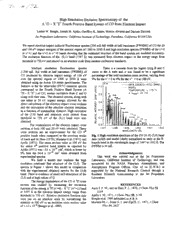
NASA Technical Reports Server (NTRS) 20000058155: High Resolution Emission Spectroscopy of the Alpha Pi-1 - Chi Sigma-1(+) Fourth Positive Band System of CO from Electron Impact PDF
Preview NASA Technical Reports Server (NTRS) 20000058155: High Resolution Emission Spectroscopy of the Alpha Pi-1 - Chi Sigma-1(+) Fourth Positive Band System of CO from Electron Impact
...... ; t-! 2 High Resolution Emission Spectroscopy of the A IH - X iE+ Fourth Positive Band System of CO from Electron Impact Luther W. Beegle, Joseph M. Ajello, Geoffrey K. James, Marcos Alvarez and Dariusz Dziczek Jet Propulsion Laboratory, California Institute of Technology, Pasadena, California 91109 USA We report electron-impact induced fluorescence spectra [300 mA full width at half maximum (FWHM)] of CO for 20 and 100 eV impact energies of the spectral region of 1300 to 2050 A and high resolution spectra (FWHM) of the ¢=5 to v'=l and the v'=3 to v"=0 bands showing that the rotational structure of the band system are modeled accurately. The excitation function of the (0,1) band (1597 A) was measured from electron impact in the energy range from threshold to 750 eV and placed on an absolute scale from modem calibration standards. Medium resolution fluorescence spectra There is a cascade from the higher lying B and C [-300 n_ full width at half maximum (FWHM)] of states to the A state and it was found to be a significant CO produced by electron impact energy of 100 eV percentage of the total excitation cross section, varying from over the spectral region of 1300 to 2050 A were 9% for the v' = 0 to 4% for the v" = 6at 100 eV. obtained using an Acton 3.0 meter spectrometer. The i .... i - l .... --1 .... :DATACO(A(3)-X(O)) BAND features in the far ultraviolet (FUV) emission spectra 1.0 ...... MODEL correspond to the Fourth Positive Band System (A I- TEMPERATURE = 17.5 °K tFI- X rE÷ ) of CO, atomic multiplets from C and O A X_u= 34 m/_ m 0.8 '_ _.= along with their ions.. The obtained spectra, along with ¢r" i _,o,) one taken at 20 eV impact energy, allowed for the 0.6 ,)IQ Qio7 O)O_=) direct calculation of the electron impact cross sections and the calculation of the absolute electron transition Lid O)Z,m_ 0.4 as a function of internuclear distance. High resolution of the (3,0) band and emission cross section from -- Ol._,Plo Psi threshold to 750 eV of the (0,1) band were also 0.2 0,_o,, .,. ol) )=)s @is obtained. o,"' °" °i:_ The recalculation of the electron impact cross 0.0 _ J,.l e,.... sections at both 100 and 20 eV were tabulated. These 1447 1".,.48 1449 1450 1451 1452 cross sections are an improvement for the CO 4a' WAVELENGTH (A) positive bands when compared to the previous works Fig. l High resolution spectrum of the CO (A-X) (3,0) band of Aarts and de Heer (1970), Mumma et al. (1971) and data (solid) and model (dash) normalized to unity at the R- Ajello (1971). The cross section value at 100 eV for branch head in the wavelength range of 1447 to 1452 _ The the entire 4th positive band system as reported by FW'HM is 34 m_ Ajello (1971) was -31 x 10"Is cm2,which is lower by 9% then the 34.4 x 10Is cm 2 value obtained from Acknowledgments experimental spectra. This work was carried out at the Jet Propulsion We built a model that explains the high Laboratory, California Institute of Technology, and was resolution rotational fine structure of the (3,0). The sponsored by the NASA Planetary Atmospheres, and spectra in Figure 1 shows this model in comparison Astrophysics Program Offices. One of us (L.W.B.) is with the experimental obtained spectra for the (3,0) supported by the National Research Council through a band. There is evidence of small self-absorption of the Resident Research Associateship at the Jet Propulsion (3,0) and at high values of Q. Laboratory. The energy dependence of the CO A tH cross section was studied by measuring the excitation REFERENCES function of the strong A q-I (v'--O) - X IE+(v"=l) band Aarts J. F. M., and de Heer F. J., 1970, J Chem Phys 52 at 1597 A in the electron impact energy range from 3554 threshold to 750 eV. Relative excitation function data Ajello J. M., 1971, JChem Phys 55, 3158 were put on an absolute scale by normalizing the Beegle et al. 1999 submitted to A & A intensity at 100 eV to an emission cross section value Mumma M. J., Stone E. J. and ZipfE. C., 1971, J Chem of 1.12 x 10"ts (Beegle et al. 1999). Phys 54, 2627
